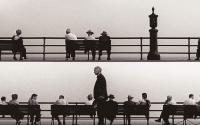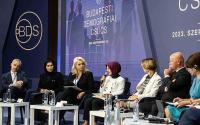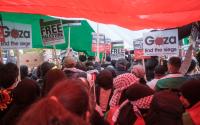21 June 2006Monetery Herald / San Jose Mercury NewsPaul Rogers
A Palo Alto, Calif. company has decided to build the world's largest factory for making solar power cells in the San Francisco Bay Area -- a move that would nearly triple the nation's solar manufacturing capacity and give a significant boost to a growing source of clean energy.
Nanosolar, a privately held company founded in 2001 with seed money from Google founders Larry Page and Sergey Brin, plans to make the announcement today, and in the next two to six weeks will select San Jose, Santa Clara or San Francisco as the site.
At capacity, the factory could turn out enough solar cells each year to generate 430 megawatts of electricity, said Nanosolar CEO Martin Roscheisen. That's enough to power about 325,000 homes.
Backers of solar power said the project is the latest example of how demand for solar energy is rapidly expanding, and how the technology, once the realm of hippies and back-to-the-land advocates, has become a hot commodity among some of the same Silicon Valley engineers and venture capitalists who made a fortune in the 1990s Internet boom.
``This is a spectacular announcement,'' said Rhone Resch, president of the Solar Energy Industries Association, in Washington, D.C. ``This is a very important step for us to address the energy crisis we face in this country. We cannot drill our way out or mine our way out, but we can manufacture our way out.''
Roscheisen said he will open the new factory, which will employ several hundred people, by the end of 2006, and expects to begin producing a type of paper-thin, flexible solar cell in 2007. Two weeks ago, he met with San Jose Mayor Ron Gonzales to discuss possible locations.
David Vossbrink, a spokesman for the city, said San Jose is willing to streamline permits and reduce building fees for the company, but has not offered cash incentives. It was unclear Tuesday what incentives, if any, San Francisco and Santa Clara might offer.
The cells, each several inches across, will be assembled in Germany into panels for use on rooftops and as stand-alone power plants. Eventually, the cells will be molded to fit archways, columns and other parts of buildings.
``This is a good space right now,'' said Roscheisen, 37, who holds a doctorate in engineering from Stanford University, and who sold his Internet company eGroups to Yahoo for $432 million in 2000.
``The market is very, very large. The technology is very complex. Once you figure out the technology, there are real opportunities.''
Globally, the solar industry totaled $11.2 billion in 2005 -- up 55 percent from a year earlier. It is projected to reach $51 billion by 2015, according to data compiled by Clean Edge, a business research firm based in Oakland.
The United States has lagged behind Japan and Europe in solar production, and is now a distant third, with about 10 percent of the global market. The new plant would move the United States to second place, behind Japan.
High oil and natural gas prices, along with concerns over global warming, are driving demand, said Ron Pernick, a spokesman for Clean Edge.
``Solar has been expanding at growth rates more akin to the personal computer industry than the energy industry,'' Pernick said. ``There is a real ramping up of manufacturing and output. This is a big coup for the Bay Area.''
Pernick noted, however, that a key question will be how fast Nanosolar can expand to full capacity to run the world's largest solar factory.
``It's one thing to announce your output target, and it is another to bring it online,'' he said. ``But if they can deliver on that, they are going to be one of the first to deliver a mass-produced thin film at competitive prices.''
About 90 percent of the world's solar energy comes from solar panels made of cells containing silicon crystals. Simply put, sunlight hits a silicon cell, exciting electrons and creating an electric current.
But Nanosolar and other companies, such as Miasole, a privately held San Jose firm, have discarded silicon as their semiconductor material. Instead, they are printing photovoltaic cells onto flexible plastic and foil, using a copper alloy that absorbs light and creates electricity.
The goal is to dramatically bring down costs, which have been the main stumbling block for expanding solar energy.
Roscheisen said Nanosolar's cells are now as efficient as traditional silicon cells, and can be manufactured at one-fifth the cost. However, its thin-film technology is not available for sale yet.
``This company is much more similar to printing a newspaper than making computer chips. We start with a giant roll of foil and print on it and cut it up,'' said Erik Straser, a general partner in MDV-Mohr Davidow Ventures of Menlo Park, one of the venture capital firms that are funding Nanosolar. The company has raised $100 million to date.
``The real innovation is that we're trying to move the photovoltaics industry from the economics of the semiconductor business to the economics of the printing business,'' Straser said.
Solar also is at the center of other Silicon Valley efforts. In November, SunPower, a San Jose spin-off of Cypress Semiconductor, went public in one of the more successful technology IPOs of the year.
Roscheisen said Nanosolar decided to open a factory in the Bay Area because it is important to be close to its R&D center in Palo Alto and because the plant will be highly automated, reducing labor costs.
``I can't even remember the last time a major manufacturing facility opened here,'' said Carl Guardino, president and CEO of the Silicon Valley Leadership Group. ``We would probably have to go back to the time of polyester suits and much wider ties.''
Environmentalists also were encouraged.
``Cleaning up the environment can be an economic opportunity,'' said Carl Pope, national executive director of the Sierra Club, in San Francisco. ``We are going to need these kind of breakthroughs. It is wonderful that Silicon Valley is taking the lead and that it is happening here.''






